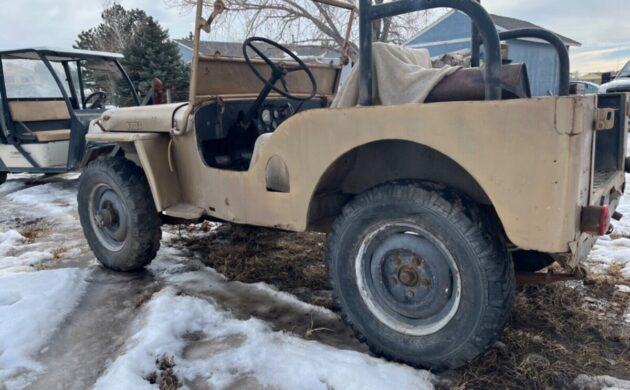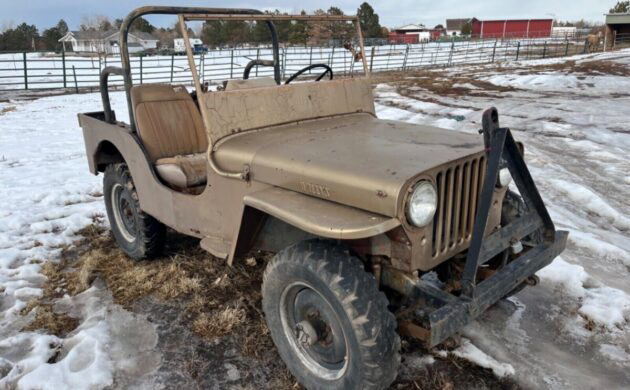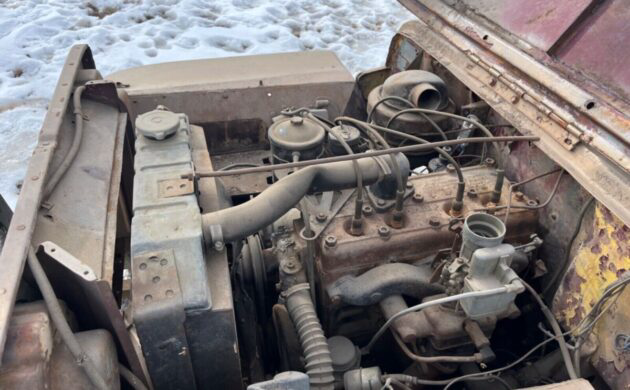Civilian Version: 1948 Willys CJ2A
Even folks who are not car buffs recognize a World War II vintage GP, or Jeep as they are commonly called. The Jeep, like Harley Davidson motorcycles, Coca Cola, and rock and roll is uniquely American. The part of the story that most folks aren’t learned up on is how the little four-wheel drive made the transition to the civilian market. If you are looking for a project vehicle that would still be a star both off road and around the farm, then check out this 1948 Willys CJ-2A for sale on eBay in Colorado Springs, Colorado. With bidding currently languishing at a low $2,650, is this little Willys a bargain for someone who loves the woods and can turn a wrench?
When you take a look back at the sacrifices made by this country during World War II, the story is staggering. Hundreds of thousands of families suffered with the loss of a loved one. A portion of those families lost even more family members. The financial cost was over four trillion dollars. Americans were restricted in their travels and food choices for years. Many of those who were not directly involved in fighting the war worked in plants that produced needed war material in plants and factories all over the country. Looking back from our comfortable perspective, the whole war’s scope and impact is almost inconceivable.
Before the war, the Army wanted a light utility vehicle. Mechanizing the Army became a priority as war clouds loomed, and American Bantam rose to the occasion by providing the Ordinance Department with what was affectionately known as the “Blitz Buggy.” The problem was that Bantam was far too small a company to produce the volume of vehicles needed. Willys and Ford ended up supplying a somewhat different version of the vehicle for the duration of the war. Willys “jeeps” were designated MBs and Ford’s version was known as the GPW. Many of the early Bantam based Jeeps ended up in Russia, and the company mainly spent the war building utility trailers that were pulled behind what was essentially their invention. In all, Willys and Ford produced over 600,000 of these unique vehicles by war’s end.
When the end came, it was a surprise to nearly everyone. A full invasion of Japan was in the works, and the fighting likely would have lasted a few more years. What followed for American armed forces was an amazingly fast wind down of the United States war machine. A lot of material and equipment was simply given away, abandoned, buried, or dumped overboard. For example, Camp Gordon Johnston near Carabelle, Florida was almost immediately shuttered. This was the site of amphibious training for what came to be known as D-Day. Once the decision was made, civilians in the area were provided a brief amount of time to take what they wanted on base (within reason, but up to and including vehicles). The rest was disposed of or dumped offshore, and the land and buildings were sold as war surplus in 1946. Stories abound about how rapidly and, in many eyes, wastefully the immense amount of war material was disposed of. That which wasn’t thrown away flooded the civilian market as cheap war surplus.
While Ford focused on producing automobiles, Willys went into the postwar period with a tremendous amount of production capacity, but a much smaller market for their civilian version of their MB. Called the CJ-2A, there were just a few differences between the military and civilian versions. These included a redesigned grille and a different transmission. Other options were offered, as the company felt that these vehicles would be used mostly on farms, ranches, and other niche markets. Despite the fact that surplus Jeeps were being sold along with incredible amounts of spare parts, an amazing 214,760 copies of the CJ-2A were sold between 1945 and 1949. Part of that was due to the ravenous market for new vehicles after the war. Another part surely was the desire for returning soldiers to have a version of their faithful wartime steed.
The version you see here is representative of how early Jeeps were used as a tool in most cases. As time went on, these beasts were subject to the hard use they were designed for. Owners didn’t hesitate to add such items as needed to keep them working and producing. Aftermarket seats, a roll bar, and an A-frame tow bar are the immediately obvious add-ons to this working vehicle.
The ad is relatively light on details. We are told that the vehicle ran ten years ago when it was parked. It also states that the engine and transmission are good. By that, I think they mean that both still rotate but should be brought back to life with reasonable care. An extra engine (seen in the back and on the driver’s seat) is included. Sadly, the tailgate is missing. There is also some rust seen in the driver’s floorboard.
All and all, this is a solid example of the CJ-2A and would be a great first restoration project for someone still building their skil set. Hopefully it finds a home with someone who will restore it and is cognizant of this returning war hero’s place in history.
Have you ever owned an early Jeep? What was the experience like? Please let us know in the comments.
Auctions Ending Soon
 1965 Ford Falcon Station WagonBid Now2 days$2,300
1965 Ford Falcon Station WagonBid Now2 days$2,300
 2002 Jaguar XK8 ConvertibleBid Now3 days$5,250
2002 Jaguar XK8 ConvertibleBid Now3 days$5,250
 1979 Chevrolet Camaro Z/28Bid Now4 days$4,500
1979 Chevrolet Camaro Z/28Bid Now4 days$4,500
 1960 Dodge D300Bid Now4 days$300
1960 Dodge D300Bid Now4 days$300
 2006 Ford Mustang Saleen S281 SCBid Now6 days$100
2006 Ford Mustang Saleen S281 SCBid Now6 days$100







Comments
A great write up, and an important reminder, “lest we forget”,,and not mentioned, but it was the atomic bomb that pulled the plug on the Pacific theater. Estimates of 130,000 to 230,000 people were killed in the 2 blasts,( many more died later) but the justification was, the war would have taken more lives had they not been dropped.
SEE? The price is much more realistic here, and I’ve said all along, don’t fall for the hype, as the world continues to deteriorate, good deals are around. The tow bar is a welcome plus, as this will have to be towed just about anywhere, to GET to the places this could, and should go. Call me nuts,,( waiting), but when I see this, the humble beginnings, I look at mine and think, FREEDOM! It’s really that special of a vehicle, and not sure other countries can have that kind of pride. If a flathead turns over, it will most likely run, and a Jeep like this in JEEP COUNTRY, USA, with 25 bids and still affordable, might suggest, I’m not so far off as some might think. The fact it’s not gone yet, should be an indicator, people might want it, but not for much. Great find, and thanks to Jeff for reminding us, it’s the greatest country in the world, but it didn’t come cheap. Amen,,
I agree, nice write-up. I remember as a kid seeing ads for those $50.00 U.S. Government Surplus Jeeps and dreaming of the day when I would earn enough money mowing lawns to get my hands on one.
I bid on this jeep
In the late 70’s my older brother had a ’48 that looked a lot like the feature car here. It needed a significant amount of T.L.C. Since he was never what you could call “Mechanically inclined” when it quit running he traded it for a Shotgun. At the time he lived 200 miles away in another state so popping over after work to help him get it going wasn’t very practical. By the time I made the trip to help out, the Jeep was gone.
My Dad bought a ’48 Jeep used in ’49. Pulled a utility trailer full of feed for the hogs he raised at the time in Illinois. Was great in the muddy feed lots. He traded it in the next year for a new ’50 Ford pickup. He was the talk of the town with the new truck.
If it were closer to Pgh pa it would motivate me to clean the junk out of garage to make room. I’ll be 80 soon but I think I could do this.
Doesn’t look mind boggling.
I bought a year unknown CJ2 in about 1984 for use as a snow plow on my property. There was plenty of rust through in the floors, no heater, and not much of anything else. But for $100 it was great at what it was used for, plowing snow.
Great write-up and detailed history, Jeff; many thanks!
Yep American manufacturing won the war. And all those manu folks were on basically limited food & limited fuel. So traveling was pretty much out for the common folk. Ration cards were the thing of the day. My parents lived thru it and one of my Uncles died in WW2, so i never got to know him.
Alot of people didn’t know the tens of 1000’s of trucks & jeeps we shipped to the Russians….or their version of blitzkrieg later in the war(1944-45), would have never been achieved. You can’t do a blitzkrieg if you can’t transport you’re troops quickly around. And America is estimated to have sent at least 152,000 Studebaker 2 & 1/2 ton trucks to them. Can you imagine, 152,000.
And during the earlier years of the Russian front(1941-43), we sent them thousands of Sherman tanks & P40 Warhawk fighters and P39 Airacobra fighters to keep them afloat, when they were getting pummeled.
Yep American Manufacturing won the war on all the fronts.
I have at least a dozen jeeps. One thing I have learned there is nothing that can be done to stop them all the parts to repair them. One thing you need to know Without an overdrive 50 is about all you can do. first thing you need is a manual most dealers.